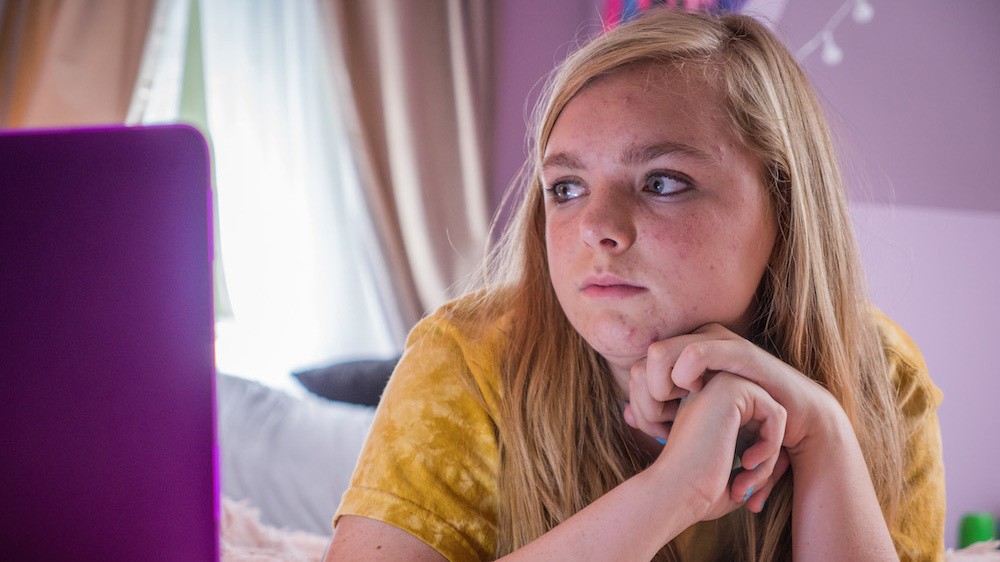
Elsie Fisher as Kayla in Eighth Grade
FULL DISCLOSURE: Once upon a time, I was in eighth grade. So I may have some bias in my feelings about this film. Eighth Grade follows Kayla (Elsie Fisher) through her last week of middle school, complete with a one-sided crush, pool party, awkward sex ed video, and all the classic elements of a teen movie. It also investigates Kayla’s online persona and relationship with social media, which, in addition to casting actual young people in the parts of the teenagers, makes the movie feel shockingly accurate.
Half the story is told through the screens of digital devices, with Kayla’s entire life outside of school revolving around her laptop and smartphone. She posts video blogs of herself speaking to her computer’s camera, with monologues that are partially the sage wisdom of self-help memes (“You can’t be brave without being scared!”) combined with tongue-tied word vomit that is both familiar and painful to watch. Although Kayla’s video blog personality preaches confidence, it’s clear that she’s uncomfortable in her skin. The success of vloggers hinges on their performance of authenticity — “being real” while simultaneously appearing optimistic, carefree, and cool — which Kayla mimics, but ultimately fails to conceal her anxiety and awkwardness.
Teens today are six times more likely to experience anxiety and depression than they were 80 years ago, thanks to the impossible expectations of neoliberalism and social media. While my generation of Old Millennials used the internet to explore our identities and our feelings through online forums and blogs, we were almost always anonymous. We had been taught that it was dangerous to use our real names, and through our internet names and avatars, we were able to play with aspects of ourselves in a private/public way without the risk of social ridicule or the permanence of making a real-life decision about how we spent our time and who we spent it with. We could choose to sit at a different lunch table in the virtual world with none of the social consequences we knew at school.
The internet I grew up with officially died when Google bought YouTube and forced us to give up our anonymity, to use our legal names in place of our chosen handles. Now that social media encourages users to showcase their real lives, teenagers perform as themselves, all of them trying to mirror what they see as acceptable or cool according to the unending feeds on their screens. In Eighth Grade, Kayla is constantly scrolling, reacting, living on her phone. In her desperation to be cool and to be accepted, she creates an overly curated online persona, applying makeup along with a video tutorial, so that she can get back in bed and post a selfie captioned, “I woke up like this, ugh.” Like many of Kayla’s statements, these words are not her own, and by utilizing memes rather than speaking in her own way, Kayla can bypass the chance that she will be judged or ostracized in case her personal thoughts are deemed “wrong.” The scrutiny, from herself and everyone around her, is constant. The performance never ends.
Kayla is probably becoming an interesting person, but most of what we learn about her is surface level. I wanted to see a little more of Kayla’s off-screen home life, but maybe she doesn’t have one. Even in her room, typically a teenager’s safe haven, Kayla obsessively interacts with an internet audience that rarely responds. She’s never truly alone. So who would Kayla be if she were performing only for herself? If she ever does get close to solitude, Dad barges in with his dorky jokes and exasperating “I love you’s.” Her replies to his attempts to communicate range from stone-cold to downright mean, mirroring the popular girls’ reactions to Kayla. The parallel hints at a larger cycle of violence, in which young people respond to traumatic experiences of growing up by enacting cruelty on each other and themselves. At school, the students participate in active shooter drills (with special thanks to the drama club) but there are no lessons on communication, compassion, or consent.
The movie never pushes too hard in any one direction, but rather orbits smoothly around its protagonist. The new frontiers of dating and sexuality are approached with caution, and thankfully, we’re spared most tired teen movie tropes. The storytelling feels gentle and supportive, with small doses of blood, fire, and tears, because it just wouldn’t be a coming-of-age story without the hard stuff. Director Bo Burnham’s well-rounded approach presented a full picture of a modern middle schooler. I’m glad he didn’t go further to tackle the reality of adolescent girlhood, considering he’s never been one. Other directors could take a page out of Burnham’s book in that regard.
ACTUAL FULL DISCLOSURE: Once upon a time, I was a dorky eighth grade girl with acne, anxiety, and exactly zero friends, just like Kayla. I also played cymbals in the school band, and if I’d had a smartphone, laptop, and wifi, I probably would’ve been just as internet-obsessed as Kayla. I related to her immensely and low-key cried through the whole movie, not only because of the genuine representation of teen girl loneliness, but also because I realized I was still holding so much pain from my life as that person, in that body, and watching this movie was a healing experience I didn’t even know I needed.